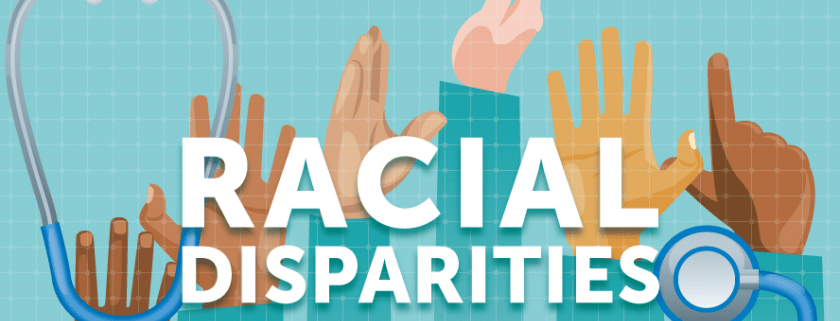Racial Disparities in Healthcare
By Virginia Quach, NAMI Dane County Intern
Racial disparities and inequities have existed in the United States for centuries, dating back to historic events such as the American Revolution, slavery and the Civil Rights Movement. However, though some progress has been made to create equal opportunities for people of color, the histories of the past and their effects still leave a mark in today’s world. In particular, discrimination in healthcare persists and studies show the damaging effects of a lack of quality healthcare for communities of color.
Discrimination refers to differences in treatment based on prejudices, stereotypes and biases one might have against an individual or group of people. Discrimination at large often results in disparities across multiple aspects of systems.
In healthcare, disparities exist from the start at prevention services to the extent of procedures and end of life care. To name a few, “Disparities are present in cardiac care, cancer screening and treatment, diabetes management, end stage renal disease, treatment of HIV infection, pediatric care, maternal and child health, mental health, rehabilitation and nursing home services, and many surgical procedures” (Nelson, 2003). Studies have shown that racial and ethnic minorities in the United States receive both quantitatively and qualitatively lower care compared to the majority population.
In an analysis of 86,000 Medicare patients with cardiovascular disease, it was found that, “whites were nearly four times more likely than African Americans to receive coronary artery bypass grafting (CABG) after adjusting for age and gender related differences in rates of myocardial infarction” (Nelson, 2003). CABG is a surgery that improves blood flow to the heart and is typically used for people who struggle with severe coronary heart disease. For whites, CABG receival rates correlated with availability of surgeons and their location in the area; meanwhile, for African Americans, physician availability and location were not related to receival of the procedure. While it can’t be scientifically proven that discrimination and prejudice definitively resulted in these outcomes, reports reflect how physicians and clinicians are influenced by their surroundings such as the environment, leading to the possibility of stereotyping and bias in their work.
Not only are African Americans more likely to receive less treatment but they also fall victim to receiving lower quality health care despite having similar insurance, status, income, and conditions as their white peers. For example, “One study of 400 hospitals in the United States showed that black patients with heart disease received older, cheaper, and more conservative treatments than their white counterparts” (Bridges, 2018). In some cases, this extends to providing Black individuals with less desirable treatments as well. This lack of treatment and failure to provide people of color with quality health care is rooted in historic and systematic racism and with persisting negligence to deal with these issues, life expectancy for these groups continues to decrease or remain uncertain.
On the topic of life expectancy, racial disparities come in the form of higher rates of chronic diseases, illnesses, and death in populations of people of color compared to their white counterparts. In fact, “Heart disease and cancer are the leading causes of death across race, ethnicity and gender. African Americans were 30 percent more likely than whites to die prematurely from heart disease in 2010, and African American men are twice as likely as whites to die prematurely from stroke” (National Academies of Sciences, 2017). Not only do African Americans receive worse or less preferable treatments in health care, but they are faced with the highest rates in some diseases, making the issue of access to quality health care even more prevalent.
Along with disparities in physical health care, people of color also face challenges in receiving and utilizing mental health resources due to institutional barriers; for example, when it comes to representation in psychiatric services, “approximately 86% of psychologists are white, and less than 2% of American Psychological Association members are African American” (Perizichilli, 2020). Despite focuses on developing cultural competency and awareness, a lack of people of color representing mental health support systems inevitably fuels bias and stereotyping that lead to health disparities. People of color are less likely to seek out and access services and are more likely to end them early.
To add on, racial disparities persist in misdiagnosis for people of color. Specifically, black men are four times more likely than white men to be diagnosed with schizophrenia; meanwhile, they are underdiagnosed for post-traumatic stress disorder and mood disorders (Perizichilli, 2020). Rather than receiving the appropriate resources to recover from their traumas, people of color are more vulnerable to being portrayed negatively and inaccurately. Even after consideration of factors such as income, insurance, and intersectionality, other factors that lead to misdiagnosis or lack of treatment for people of color lie in cultural fears, stigmas and mistrust against the system.
In the current case of the COVID-19 pandemic, studies have shown that once again, communities of color have been affected disproportionately more compared to others. According to reports at Wisconsin Public Radio, “nationally, African American deaths from COVID-19 are nearly two times greater than would be expected based on their share of the population. In four states, the rate is three or more times greater” (Godoy, 2020). This is largely due to the fact that African Americans typically have less access to quality health care and disproportionately constitute essential frontline jobs, overall creating more exposure. In Wisconsin particularly, “at least 141 African Americans have died, representing 27% of all deaths in a state where just 6% of the state’s population is black” (Godoy, 2020).
To close gaps in racial disparities, some solutions lie in enhancing connections between health care systems and the communities they serve and allocating necessary resources to these people. Due to COVID-19, a recent rising support system that has particularly served communities of color well is telehealth services. These services increase access to care as rural or geographically isolated locations can be served at their convenience. Additionally, it can enhance face-to-face medicine by providing remote check ups, follow ups, and education when necessary.
Though telemedicine alleviates some challenges for communities, health equity is still a growing issue in today’s society and the ongoing pandemic simply highlights one of the many ways communities of color are left at a disadvantage. To close these gaps, it is important to create safe and convenient spaces for people of color to access health care. Most importantly, resources and funding need to be invested into these spaces to provide high quality care. Additionally, the experiences and narratives of people of color must be acknowledged and validated for systems to improve and determine the best solutions. The U.S. Census Bureau estimates that by 2044 the nation’s population will constitute a majority of racial or ethnic minorities. Some states such as California already demonstrate these projections. Therefore, it is especially critical that healthcare and other institutions advance to tackle issues in racial disparities within their departments as the future demands for greater attention to these groups that are already underserved and neglected. With further acknowledgement of the experiences of people of color and perseverance to create quality spaces and resources for minorities to access, health care can improve to eliminate current racial disparities.
Sources:
Bridges, Khiara M. “Implicit Bias and Racial Disparities in Health Care.” American Bar Association, 2018, www.americanbar.org/groups/crsj/publications/human_rights_magazine_home/the-state-of-healthcare-in-the-united-states/racial-disparities-in-health-care/.
Godoy, Maria, and Daniel Wood. “What Do Coronavirus Racial Disparities Look Like State By State?” NPR, NPR, 30 May 2020, www.npr.org/sections/health-shots/2020/05/30/865413079/what-do-coronavirus-racial-disparities-look-like-state-by-state.
National Academies of Sciences. “The State of Health Disparities in the United States.” Communities in Action: Pathways to Health Equity., U.S. National Library of Medicine, 11 Jan. 2017, www.ncbi.nlm.nih.gov/books/NBK425844/.
Nelson, A. R. (2003). Unequal Treatment: Report of the Institute of Medicine on Racial and Ethnic Disparities in Healthcare (Rep.). Fairfax, Virginia: IOM Committee on Understanding and Eliminating Racial and Ethnic Disparities in Health Care.
Perzichilli, Tahmi. “The Historical Roots of Racial Disparities in the Mental Health System.” Counseling Today, 12 May 2020, ct.counseling.org/2020/05/the-historical-roots-of-racial-disparities-in-the-mental-health-system/.


